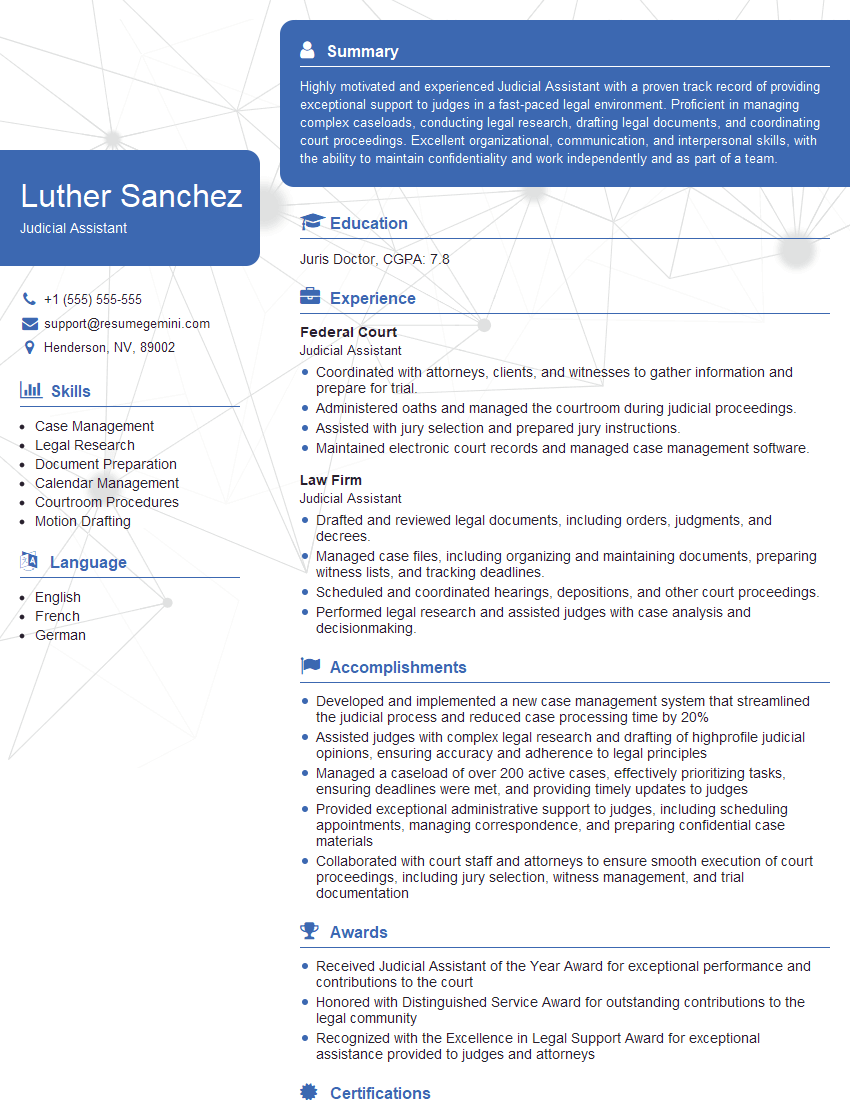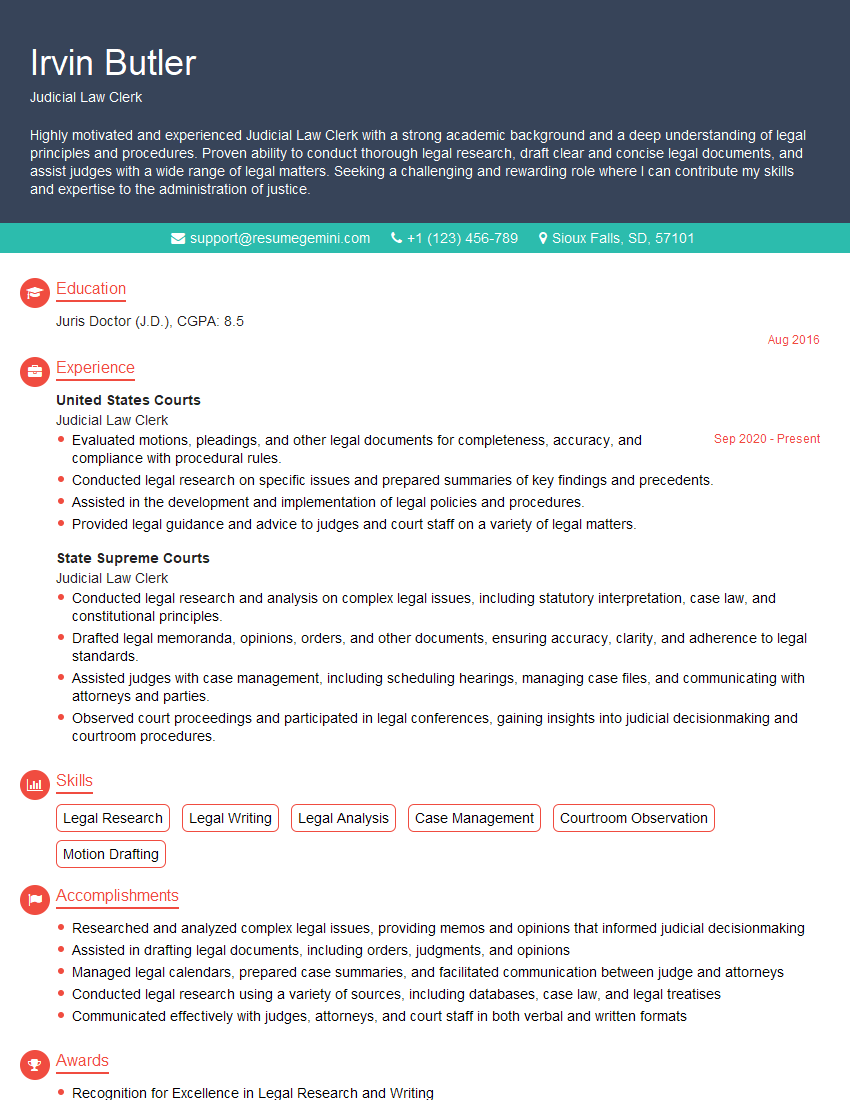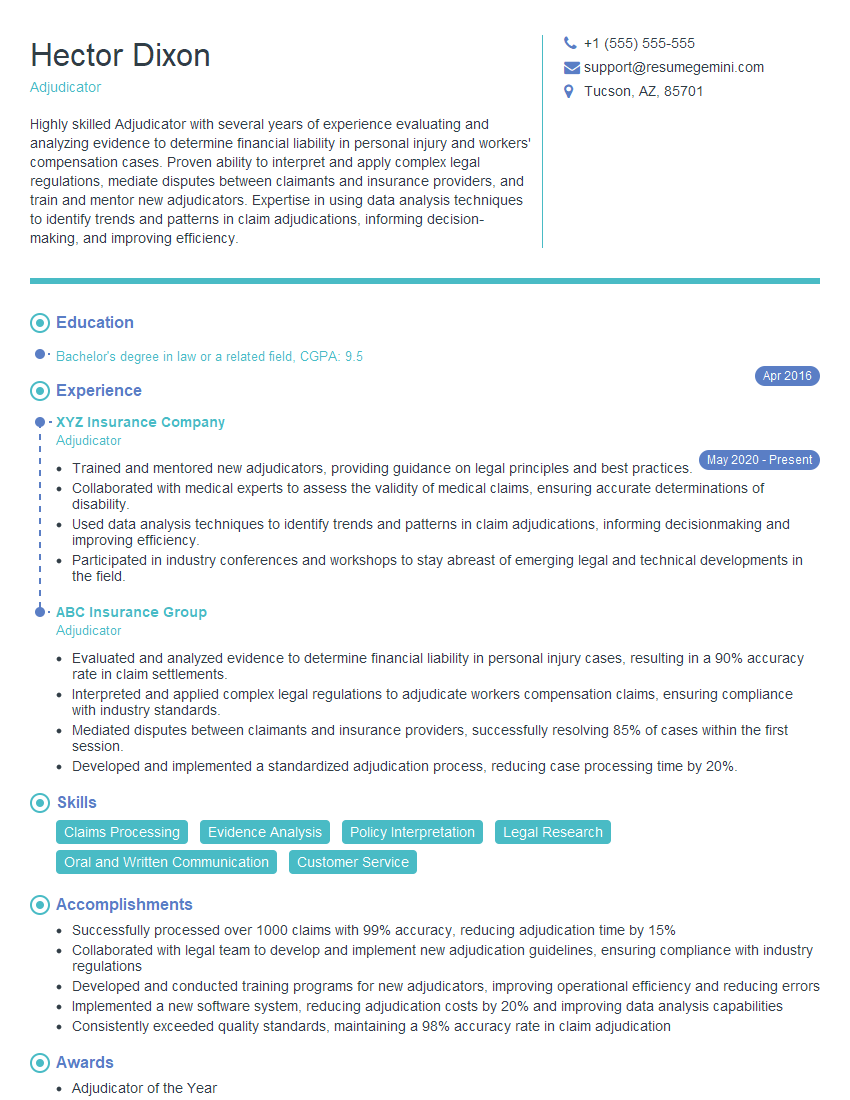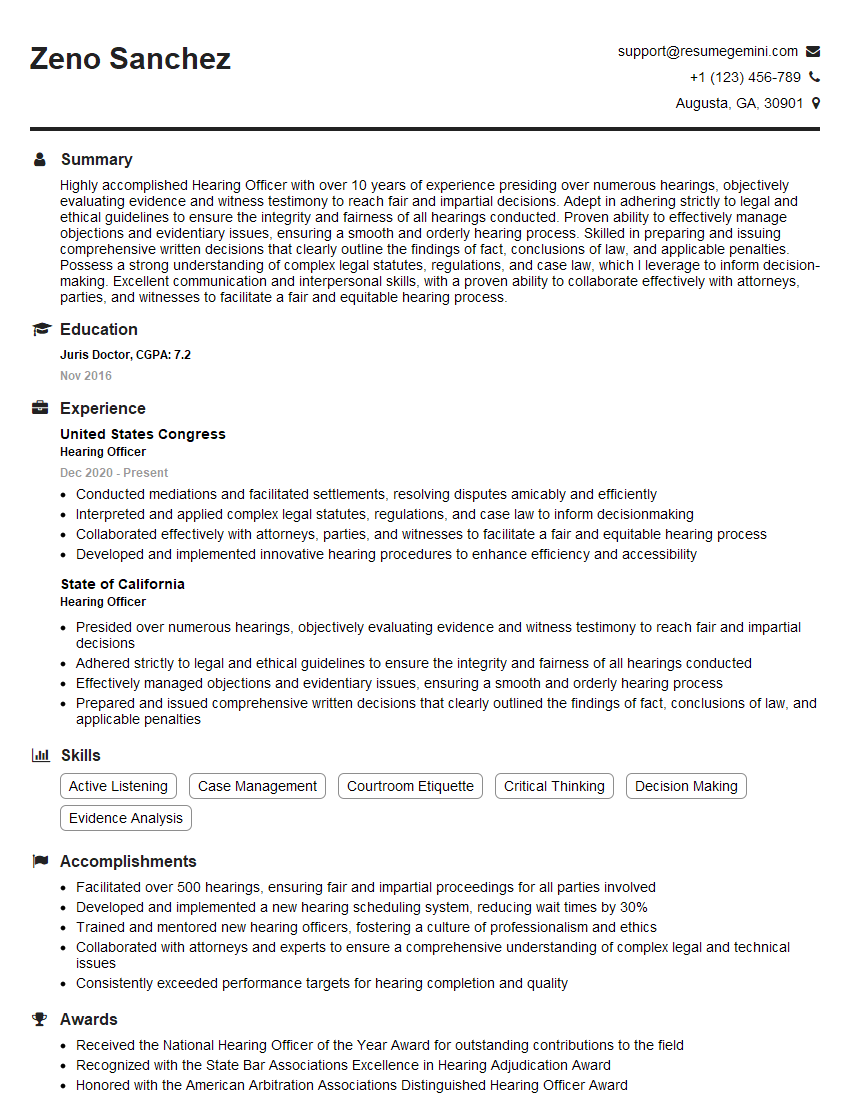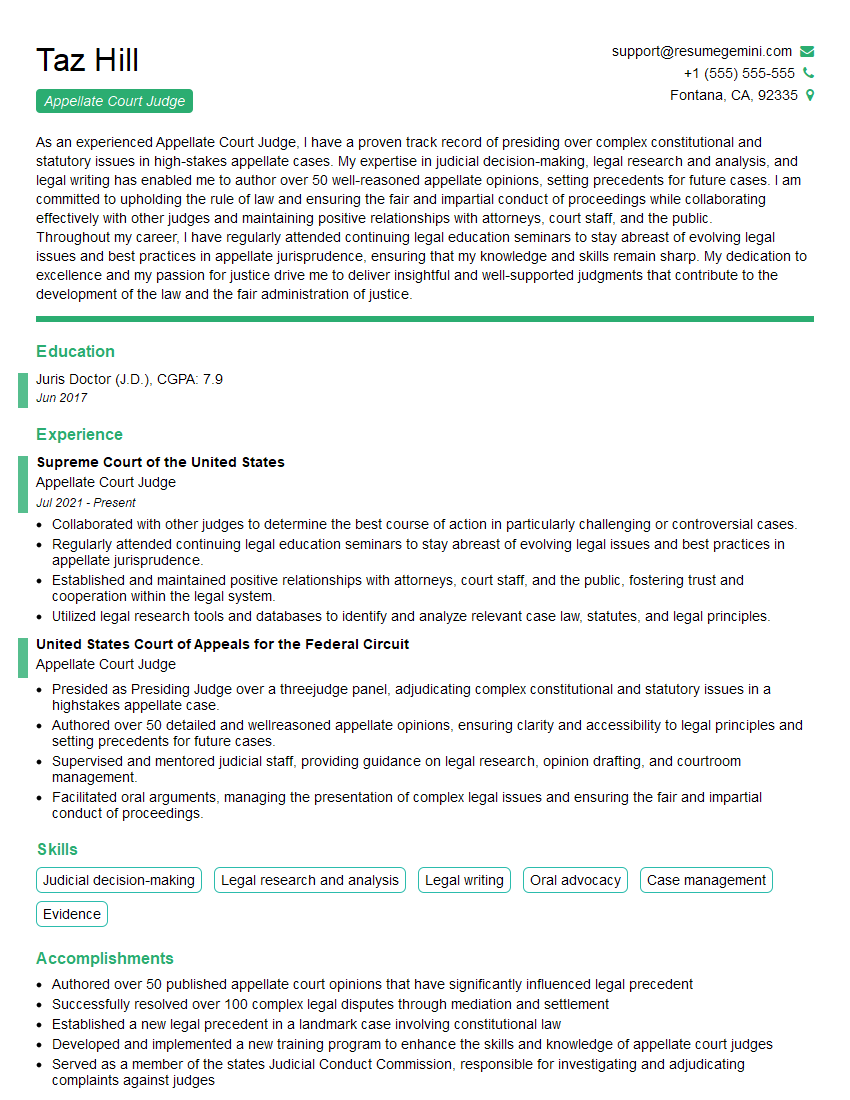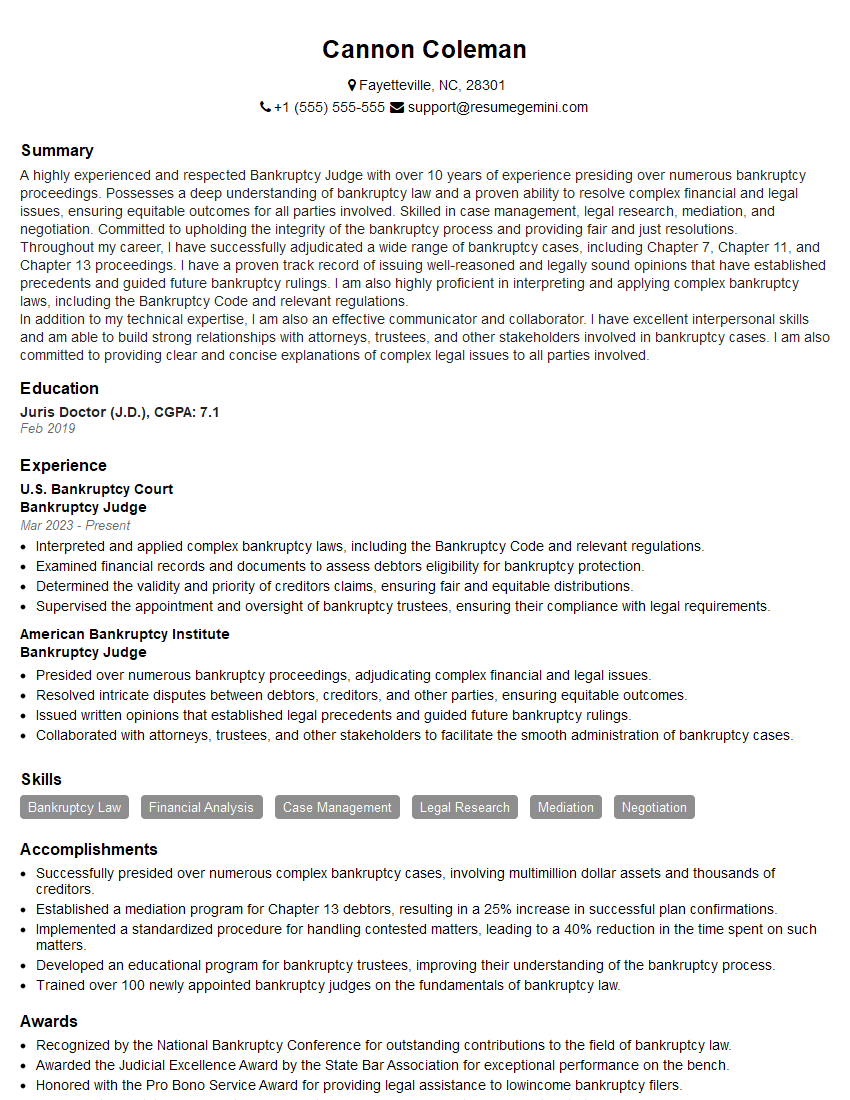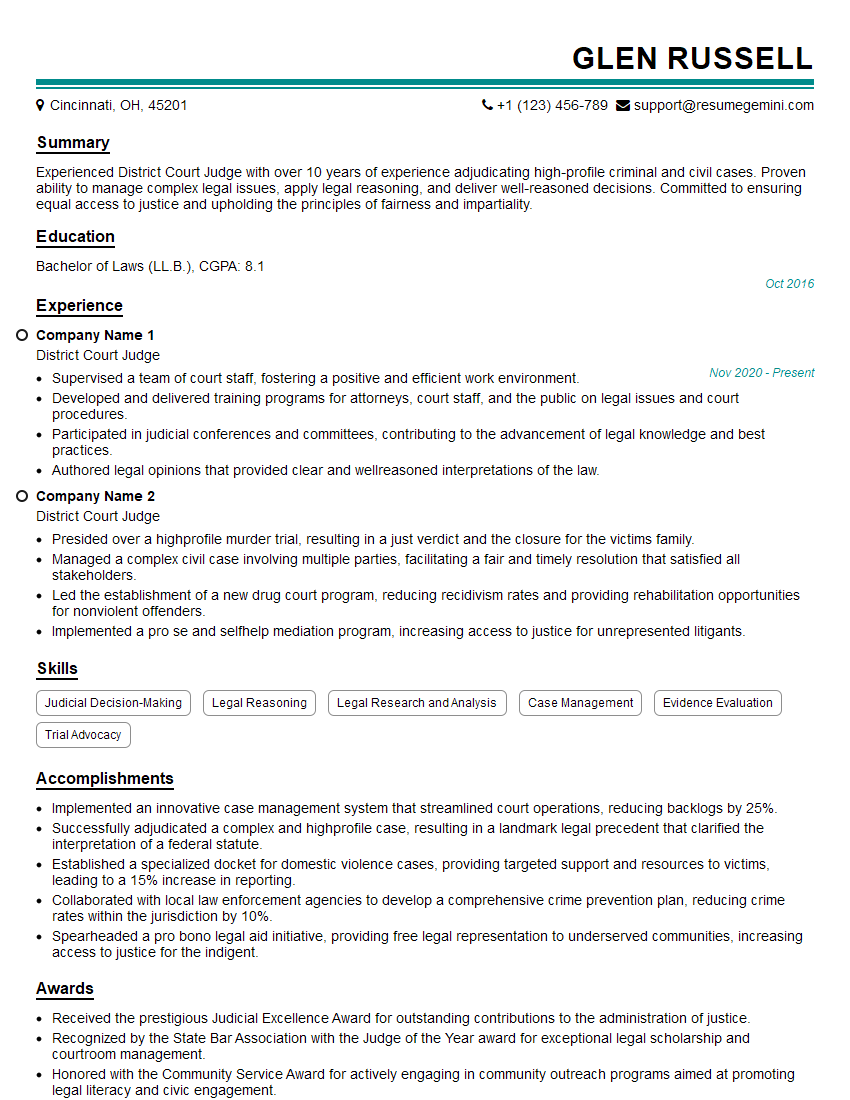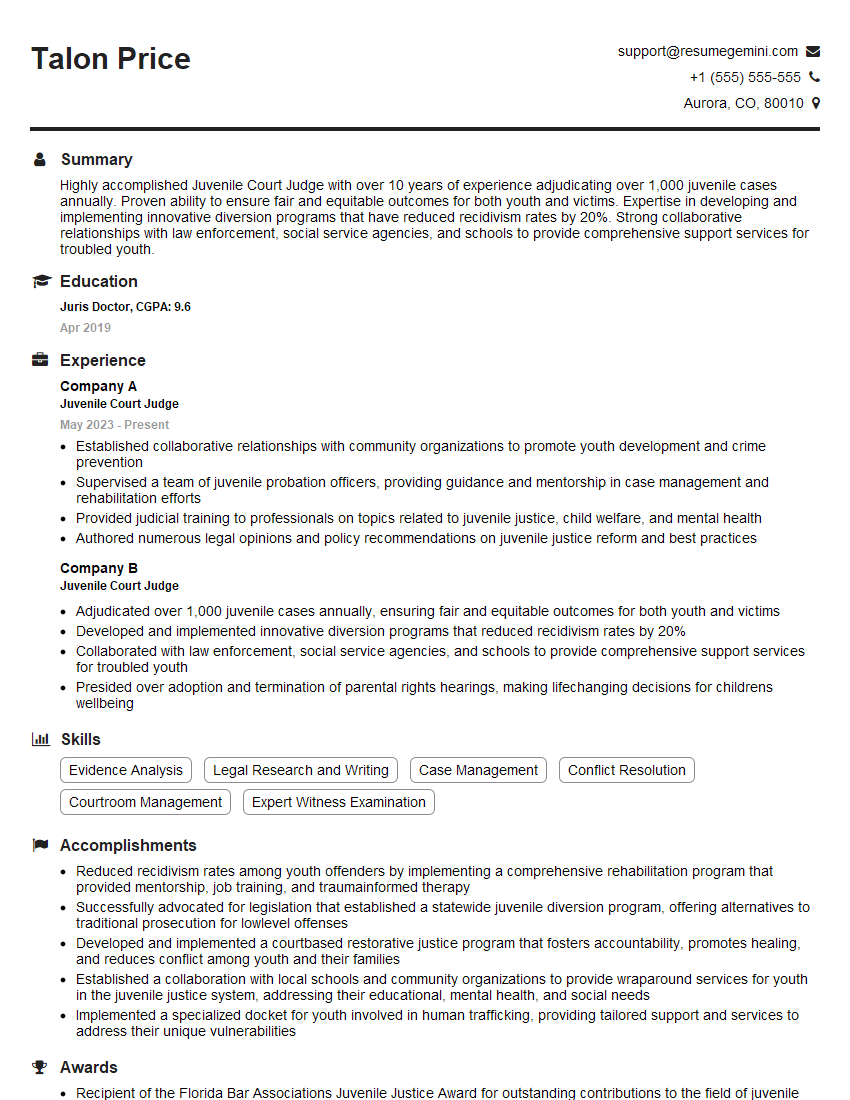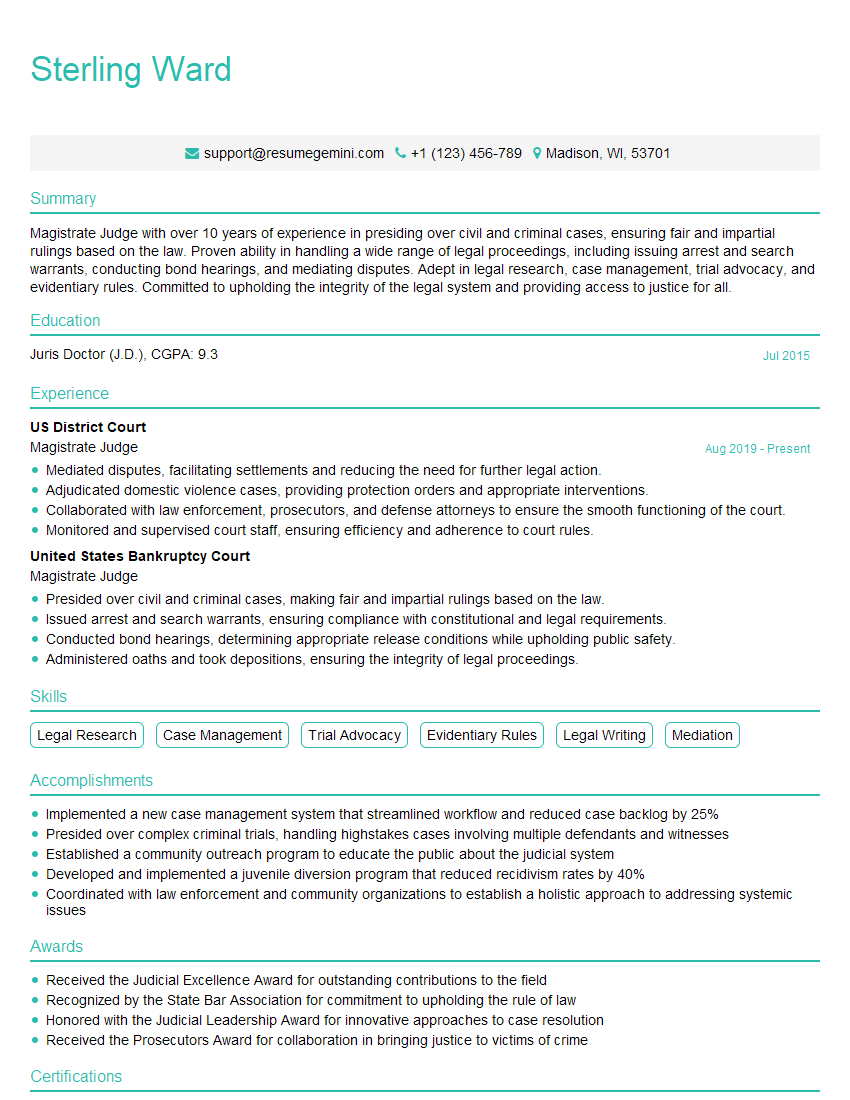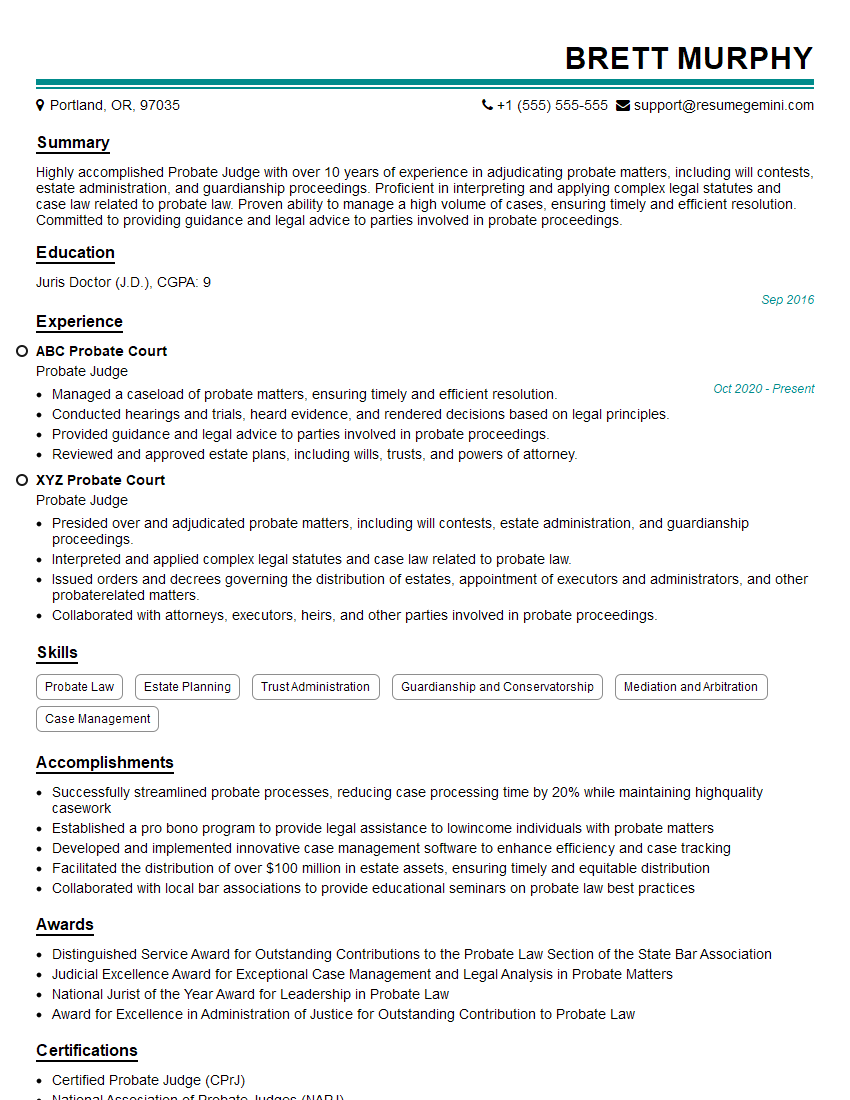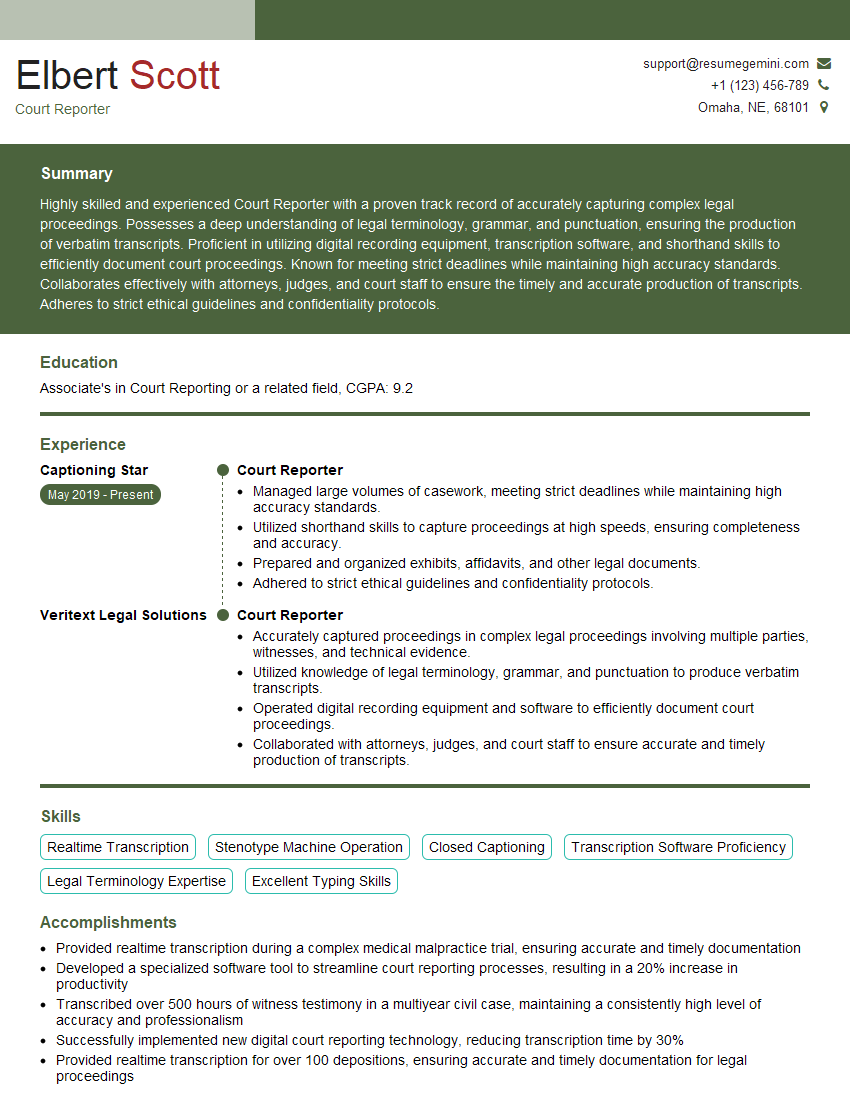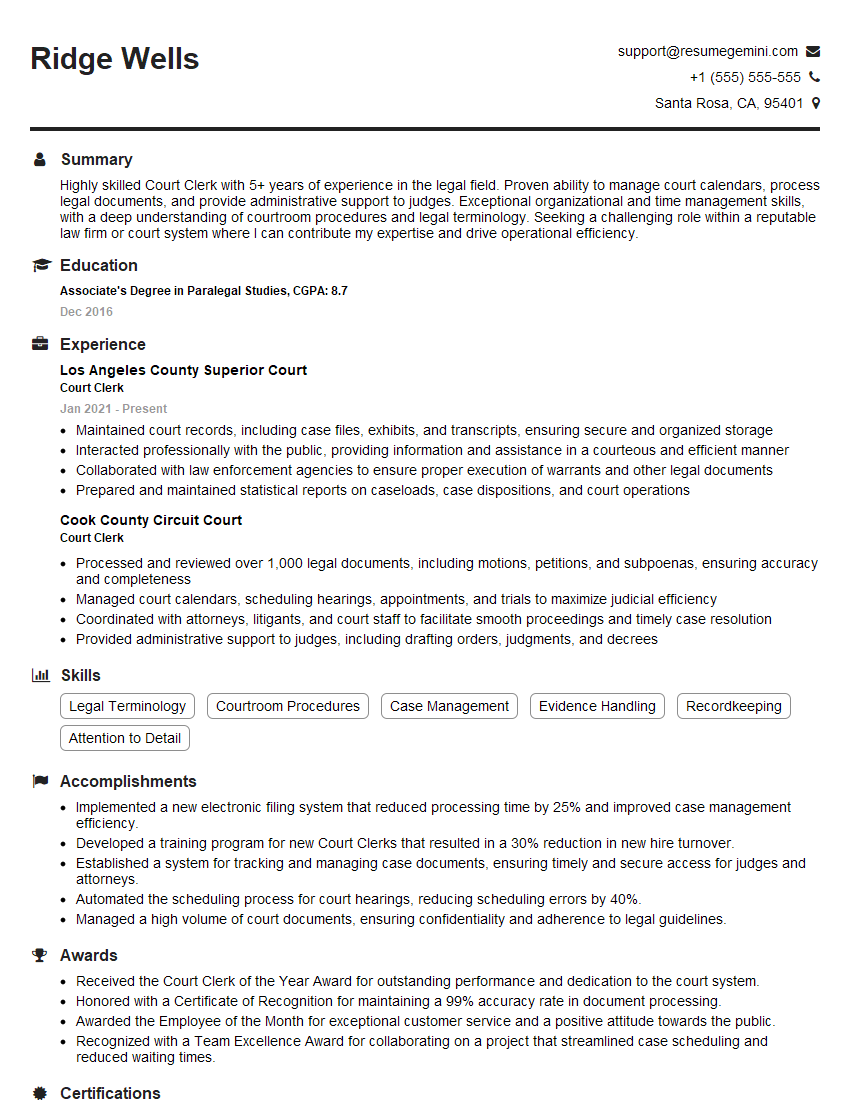Preparation is the key to success in any interview. In this post, we’ll explore crucial Judgment Law interview questions and equip you with strategies to craft impactful answers. Whether you’re a beginner or a pro, these tips will elevate your preparation.
Questions Asked in Judgment Law Interview
Q 1. Explain the difference between a judgment and an order.
While both judgments and orders are court pronouncements, they differ significantly in their scope and effect. A judgment is a final determination of the rights and liabilities of the parties in a case. It resolves the core dispute and usually awards damages, grants specific performance, or issues other forms of relief. Think of it as the court’s ultimate decision on the merits of the case. An order, on the other hand, is a court directive addressing procedural matters, interim relief, or other subsidiary issues within a case. It doesn’t resolve the main dispute but rather guides the case’s progress. For instance, an order might grant a temporary injunction or set a trial date. The key difference lies in finality; a judgment is final (unless appealed), while an order is typically interlocutory (meaning it’s part of the ongoing process).
Example: In a breach of contract case, the judgment might award the plaintiff $10,000 in damages. An order in the same case might be to compel the defendant to produce certain documents.
Q 2. Describe the process of enforcing a judgment.
Enforcing a judgment involves the process of compelling the losing party to comply with the court’s decision. The methods vary depending on the type of judgment and the jurisdiction, but common methods include:
- Writ of Execution: This authorizes the seizure and sale of the judgment debtor’s assets to satisfy the judgment amount. This could involve bank accounts, real estate, or personal property.
- Garnishment: This allows a portion of the judgment debtor’s wages, bank accounts, or other receivables to be directly paid to the judgment creditor.
- Attachment: This involves seizing specific assets of the debtor before the judgment is even finalized, usually when there’s a risk the debtor might hide or dissipate assets.
- Contempt of Court: If the judgment involves a specific act, like fulfilling a contract, non-compliance can lead to contempt charges, potentially resulting in fines or imprisonment.
The process often involves obtaining a writ of execution from the court and engaging a bailiff or sheriff to carry out the enforcement. The complexity can increase if the debtor is uncooperative or attempts to hide assets.
Q 3. What are the common grounds for setting aside a judgment?
Courts have inherent powers to set aside judgments – essentially to undo a decision – under limited circumstances. Common grounds include:
- Mistake or error: This includes clerical errors, misinterpretations of evidence, or procedural irregularities that significantly affected the outcome.
- Fraud or misrepresentation: If a party obtained a judgment through fraudulent means, such as perjury or the withholding of crucial evidence, the judgment can be set aside.
- Lack of jurisdiction: If the court lacked the authority to hear the case in the first place, the judgment is voidable.
- Newly discovered evidence: Evidence that was unavailable at the time of the trial and that could materially alter the outcome might justify setting aside the judgment.
- Non-compliance with court rules or procedures: Significant violations of court rules which prejudiced the affected party can be grounds for setting aside a judgment.
The application to set aside a judgment must usually be made promptly and within a specified timeframe after the judgment is entered. It requires demonstrating good cause and usually involves supporting evidence.
Q 4. Explain the concept of res judicata and its implications.
Res judicata, meaning ‘the thing has been judged,’ is a doctrine preventing the relitigation of issues already decided in a prior lawsuit between the same parties. It promotes finality, efficiency, and consistency in the judicial system. If a court has already rendered a final judgment on a particular claim, that judgment is conclusive and binding on the same parties in any subsequent action involving the same claim or cause of action.
Implications: Res judicata prevents endless litigation on the same issue. It safeguards parties from the costs and burdens of repeated trials and ensures that court decisions are respected and not easily challenged. However, exceptions exist, such as when new evidence emerges or if the earlier judgment was based on fraud.
Example: If a plaintiff sues a defendant for breach of contract and loses, they cannot later sue the same defendant for the same breach of contract. The first judgment acts as a bar to the second action.
Q 5. What are the different types of judgments available in your jurisdiction?
The specific types of judgments available vary by jurisdiction, but common types include:
- Default Judgment: Awarded when a defendant fails to respond to a lawsuit within the allocated time.
- Summary Judgment: Granted when there are no genuine issues of material fact in dispute and the moving party is entitled to judgment as a matter of law.
- Judgment on the pleadings: Granted based solely on the pleadings (complaint and answer) without needing a trial.
- Judgment after trial: Issued after a full trial where evidence has been presented and considered.
- Consent judgment: Agreed upon by the parties involved and entered as a court order.
The availability and precise application of these types of judgment are determined by specific procedural rules in each jurisdiction.
Q 6. How do you determine the appropriate amount of damages in a judgment?
Determining the appropriate amount of damages in a judgment requires a careful assessment of the plaintiff’s losses and the defendant’s liability. The goal is to restore the plaintiff to the position they would have been in had the wrong not occurred (restitutio in integrum). Several factors are considered:
- Type of damages: This includes compensatory damages (covering actual losses), punitive damages (punishing the defendant for egregious conduct), and nominal damages (acknowledging a wrong but without significant financial loss).
- Proof of loss: The plaintiff bears the burden of proving their losses with credible evidence, such as receipts, invoices, expert testimony, and medical records.
- Causation: The plaintiff must show a direct causal link between the defendant’s actions and the losses suffered.
- Mitigation of damages: The plaintiff has a duty to take reasonable steps to mitigate or lessen their losses. Failure to do so might reduce the recoverable damages.
- Foreseeability: Damages must be reasonably foreseeable at the time of the defendant’s wrongful act.
In some cases, expert witnesses, such as accountants or economists, may be needed to quantify economic damages. The judge or jury then weighs the evidence and determines the appropriate amount of damages based on the relevant legal principles and the evidence presented.
Q 7. What is the role of precedent in judicial decision-making?
Precedent, also known as stare decisis (‘to stand by things decided’), plays a crucial role in judicial decision-making. It refers to the principle that courts should follow the decisions of higher courts within the same jurisdiction in similar cases. This fosters consistency and predictability in the application of the law. Judges are bound by precedent set by superior courts, creating a hierarchical system where lower courts must follow the rulings of higher courts.
How it works: When a judge encounters a legal issue, they will research prior case law to see if similar cases have already been decided. If a relevant precedent exists, the judge will generally follow it, unless there are compelling reasons to distinguish the case or overturn the precedent (often requiring a higher court to do so). This ensures fairness and avoids contradictory judgments on similar situations. However, judges have some flexibility in interpreting and applying precedent to the facts of a particular case.
Example: If a state supreme court rules that a particular type of contract is unenforceable, lower courts in that state must follow that ruling in subsequent similar cases. This ensures that the same legal rule applies consistently throughout the state.
Q 8. Explain the concept of stare decisis.
Stare decisis, a Latin term meaning “to stand by things decided,” is a fundamental principle in common law systems. It dictates that courts should follow precedents set by previous decisions when deciding similar cases. This promotes consistency, predictability, and fairness in the application of the law. Think of it like building with Lego bricks; each decision adds a brick to the structure, and future decisions should fit logically with what’s already built.
There are two main types: vertical stare decisis, where lower courts must follow the precedents set by higher courts within the same jurisdiction, and horizontal stare decisis, where courts at the same level generally follow their own prior decisions. However, courts are not bound by precedent indefinitely; they can overturn previous decisions, particularly if they are deemed outdated, incorrect, or unjust. The Supreme Court’s decision to overturn Roe v. Wade is a prime example of this.
Q 9. How does a court deal with conflicting precedent?
When courts encounter conflicting precedents, they engage in a process of legal analysis to reconcile the discrepancies. This involves examining the facts, reasoning, and legal principles underlying each precedent to determine which precedent is more persuasive or applicable to the current case. Several strategies are employed:
- Distinguishing the cases: The court may find that the facts of the current case are sufficiently different from the precedents, making one precedent inapplicable.
- Overruling a precedent: A higher court can explicitly overturn a prior decision from a lower court or even its own prior decision if it finds the precedent to be erroneous or no longer reflects current societal values or legal understanding.
- Reconciling the precedents: The court may attempt to harmonize the apparently conflicting precedents by finding common ground or interpreting them in a way that resolves the conflict.
- Certiorari to a higher court: If the conflict is significant, the case may be appealed to a higher court to resolve the issue definitively.
The process is complex and requires a deep understanding of legal doctrine and judicial precedent. The ultimate goal is to arrive at a just and consistent resolution that aligns with established legal principles.
Q 10. Discuss the impact of equity on judgments.
Equity plays a significant role in shaping judgments, particularly when strict application of common law rules would lead to unfair or unjust outcomes. Equity, historically administered in separate courts of Chancery, focuses on fairness and justice. While initially distinct, equity and common law have now largely merged. Equity provides remedies beyond those available at common law such as specific performance (ordering a party to fulfill a contract) or injunctions (ordering a party to stop certain actions).
For example, if a contract is breached and monetary damages would not adequately compensate the injured party, a court of equity might order specific performance to compel the breaching party to fulfill their contractual obligations. Equity operates as a corrective mechanism, ensuring that the rigid application of the law doesn’t result in injustice. This ‘safety net’ of fairness is crucial for a balanced legal system.
Q 11. Describe the process of appealing a judgment.
Appealing a judgment involves challenging the lower court’s decision in a higher court. The process generally begins with filing a notice of appeal within a specified timeframe, outlining the grounds for the appeal. This is followed by submitting a formal appellate brief, which argues why the lower court’s decision was erroneous. The appellant (the party appealing) must demonstrate that the lower court made a legal error (e.g., misapplication of the law, erroneous admission of evidence) or that the decision was not supported by the facts.
The appellate court reviews the record from the lower court—the trial transcript, exhibits, and other relevant documents—and may hear oral arguments from both sides. The appellate court can affirm, reverse, or modify the lower court’s judgment. The decision of the appellate court may be further appealed to a higher court, depending on the jurisdiction and the specific circumstances of the case.
Q 12. Explain the different standards of review used in appeals.
Appellate courts use different standards of review depending on the type of issue being appealed. These standards determine the level of deference given to the lower court’s decision.
- De novo review: The appellate court reviews the issue afresh, without deference to the lower court’s decision. This is typically used for legal questions, where the appellate court is as well-equipped as the lower court to make the determination.
- Abuse of discretion review: The appellate court will only overturn the lower court’s decision if it finds that the lower court acted arbitrarily or unreasonably. This standard is generally applied to decisions involving the lower court’s exercise of discretion, such as evidentiary rulings.
- Clearly erroneous review: The appellate court will overturn the lower court’s findings of fact only if they are clearly erroneous, meaning that the appellate court is left with a definite and firm conviction that a mistake has been committed. This standard emphasizes the lower court’s role in evaluating evidence and assessing witness credibility.
The appropriate standard of review significantly impacts the outcome of an appeal, reflecting the differing roles and expertise of trial and appellate courts.
Q 13. How does a court handle jurisdictional challenges?
Jurisdictional challenges question whether a court has the authority to hear a particular case. These challenges can be raised at any stage of the litigation. Courts must have both subject matter jurisdiction (the power to hear the type of case) and personal jurisdiction (the power over the parties involved).
If a court lacks jurisdiction, it must dismiss the case. Challenges to subject matter jurisdiction can generally be raised at any time, even after a judgment. Challenges to personal jurisdiction must typically be raised at the beginning of the case, or they may be waived. A court will examine the relevant statutes and legal precedents to determine if it possesses the necessary jurisdiction. Failure to establish jurisdiction renders the entire proceeding invalid.
Q 14. What are the ethical considerations involved in judicial decision-making?
Ethical considerations are paramount in judicial decision-making. Judges are expected to be impartial, unbiased, and to adhere to a strict code of conduct. Key ethical considerations include:
- Impartiality and fairness: Judges must avoid conflicts of interest and ensure that their decisions are not influenced by personal biases or external pressures.
- Due process: Judges must ensure that all parties receive a fair hearing and that their rights are protected throughout the legal process.
- Transparency and accountability: Judicial decisions should be based on clear legal principles and reasoning, and judges should be accountable for their actions.
- Integrity and honesty: Judges must uphold the highest standards of integrity and honesty in all aspects of their work.
- Respect for the law: Judges must respect and uphold the rule of law, even when facing difficult or controversial cases.
Breaches of these ethical principles can lead to sanctions, including impeachment, removal from office, and disciplinary actions. Maintaining judicial integrity is fundamental to the public’s trust in the justice system.
Q 15. Explain the concept of due process and its relevance to judgments.
Due process is the legal principle that ensures fairness and justice in legal proceedings. It guarantees that individuals are treated fairly and have the opportunity to be heard before the court makes a decision that affects their rights. This is crucial to ensuring judgments are legitimate and uphold the rule of law.
In the context of judgments, due process means several things:
- Notice: Individuals must be properly notified of any legal proceedings that affect them.
- Opportunity to be heard: Individuals must have the chance to present their case, including presenting evidence and witnesses.
- Impartial tribunal: The court must be neutral and unbiased in its handling of the case.
- Right to counsel: Individuals have the right to legal representation, especially in complex cases.
For example, imagine someone is sued and never receives notification of the lawsuit. A judgment against them would violate due process because they never had a chance to defend themselves. The fairness of the entire legal system relies on upholding this fundamental principle.
Career Expert Tips:
- Ace those interviews! Prepare effectively by reviewing the Top 50 Most Common Interview Questions on ResumeGemini.
- Navigate your job search with confidence! Explore a wide range of Career Tips on ResumeGemini. Learn about common challenges and recommendations to overcome them.
- Craft the perfect resume! Master the Art of Resume Writing with ResumeGemini’s guide. Showcase your unique qualifications and achievements effectively.
- Don’t miss out on holiday savings! Build your dream resume with ResumeGemini’s ATS optimized templates.
Q 16. How does a court handle situations involving conflicting evidence?
When conflicting evidence arises, the court’s role is to act as a trier of fact. This means they must carefully weigh all evidence presented, considering its credibility and reliability. The judge (or jury) will assess the witness testimony, physical evidence, and any other supporting documentation to determine which version of events is most likely true.
Several factors influence the court’s decision:
- Witness credibility: The court evaluates the demeanor, consistency, and potential biases of witnesses.
- Evidence reliability: The court assesses the quality and source of the evidence, considering whether it’s been tampered with or misinterpreted.
- Corroborating evidence: The court looks for evidence that supports one side’s account over the other.
- Burden of proof: The court considers which party bears the burden of proving their case (more on this in question 4).
Imagine a car accident case with conflicting eyewitness accounts. The court might consider whether one witness has a better vantage point, a clearer recollection of events, or if their testimony aligns with physical evidence like skid marks or damage to the vehicles. The judge or jury then make a determination based on the weight of evidence, not simply the quantity.
Q 17. What is the role of jury instructions in reaching a judgment?
Jury instructions are crucial because they guide the jury’s deliberations and ensure a consistent application of the law to the facts of the case. The judge provides instructions that explain the relevant legal principles, define key terms, and outline the burden of proof. These instructions must be accurate and neutral to avoid influencing the jury’s decision improperly.
For example, in a criminal trial, the judge would instruct the jury on the elements of the crime charged (e.g., proving beyond a reasonable doubt that the defendant committed the act and had the required intent). These instructions help the jury apply the law correctly to the evidence presented. Instructions that are incomplete, unclear, or biased can lead to a flawed verdict and potentially require a retrial.
Q 18. Explain the concept of burden of proof in a legal proceeding.
The burden of proof refers to the responsibility of a party in a legal proceeding to prove their case. The level of proof required varies depending on the context. In civil cases, the burden of proof is usually on the plaintiff (the person bringing the lawsuit) to prove their case by a ‘preponderance of the evidence’ – meaning the evidence presented makes it more likely than not that the claim is true.
In criminal cases, the burden of proof is on the prosecution to prove the defendant’s guilt ‘beyond a reasonable doubt’ – a significantly higher standard requiring a near certainty of guilt. This is because the consequences of a wrongful conviction are far more severe than a wrongful civil judgment.
For example, in a civil case for breach of contract, the plaintiff must prove that a contract existed, that the defendant failed to fulfill their obligations under the contract, and that the plaintiff suffered damages as a result. In a criminal case for theft, the prosecution must prove beyond a reasonable doubt that the defendant took property belonging to another, without permission, and with the intent to permanently deprive the owner of the property. The burden of proof dictates which side needs to present the stronger evidence to succeed in their claim.
Q 19. How does a court handle cases involving multiple parties?
Cases involving multiple parties can become quite complex. The court must manage the proceedings to ensure fairness and efficiency. This might involve consolidating similar claims, appointing lead plaintiffs in class-action lawsuits, or staggering the presentation of evidence to avoid overwhelming the court.
The court may use different procedural mechanisms like:
- Consolidation: Combining multiple cases with similar issues into one trial.
- Intervention: Allowing additional parties to join the lawsuit if their interests are affected.
- Interpleader: A procedure used when a party holds property that is claimed by multiple parties.
- Class actions: Lawsuits where a representative plaintiff sues on behalf of a large group of individuals with similar claims.
For instance, a car accident involving multiple vehicles and injured passengers might lead to several lawsuits. The court could consolidate these cases to streamline the process, or it might separate the injury claims from the property damage claims for clarity and efficiency.
Q 20. What are the procedures for default judgment?
A default judgment is entered when a defendant fails to respond to a lawsuit within the time allowed by the court. The procedure varies slightly by jurisdiction, but generally involves these steps:
- Filing of the Complaint: The plaintiff initiates the lawsuit by filing a complaint with the court, properly serving the defendant.
- Defendant’s Failure to Respond: The defendant fails to file an answer or other response within the specified time (often 20-30 days).
- Motion for Default Judgment: The plaintiff files a motion with the court requesting a default judgment against the defendant.
- Hearing (Sometimes): The court may hold a hearing to determine the appropriate amount of damages or other relief for the plaintiff.
- Entry of Default Judgment: The court enters the default judgment, which means the plaintiff wins the case without a full trial.
It’s important to note that default judgments aren’t always automatic. The court has discretion to set aside a default judgment if the defendant can show a good reason for their failure to respond. For example, illness or a misunderstanding could justify setting aside a default judgment.
Q 21. How are judgments enforced internationally?
Enforcing judgments internationally is complex because each country has its own legal system. There isn’t a single global system for enforcing judgments. International cooperation is key, usually relying on treaties or reciprocal arrangements between nations. The process often involves obtaining a judgment in one country and then seeking recognition and enforcement of that judgment in another country.
Key methods include:
- Treaty-based enforcement: Many countries have signed treaties that facilitate the recognition and enforcement of judgments across borders. The Hague Convention on Choice of Court Agreements is an example.
- Reciprocity: Some countries will enforce foreign judgments based on the principle of reciprocity – meaning they will enforce a judgment from another country if that country would reciprocally enforce their judgments.
- Direct action: In some cases, a creditor can directly sue in a foreign court to enforce the judgment.
The success of international judgment enforcement depends on many factors, including the type of judgment, the relationship between the countries involved, and the evidence presented. It’s frequently a lengthy and expensive process, requiring specialized legal expertise.
Q 22. Describe the concept of summary judgment.
Summary judgment is a procedural device in civil litigation that allows a court to conclude a case before trial if it finds that there is no genuine dispute of material fact and that the moving party is entitled to judgment as a matter of law. Essentially, it’s a shortcut to avoid a full-blown trial when the case lacks sufficient merit.
Think of it like this: imagine a game of chess where one player has a checkmate clearly visible. A summary judgment is like the referee declaring checkmate without waiting for all the remaining moves to be played. It saves time and resources.
To obtain summary judgment, the moving party must present evidence demonstrating the lack of a genuine factual dispute. The opposing party can counter with their own evidence. The judge then determines if a trial is truly necessary based on the submitted materials. If there’s a clear winner based on undisputed facts and applicable law, summary judgment is granted.
For example, in a breach of contract case, if the defendant admits to signing the contract and failing to perform as agreed, and there’s no valid defense presented, a summary judgment in favor of the plaintiff might be granted.
Q 23. What are the limitations on the enforcement of judgments?
Several limitations exist on enforcing judgments. These limitations ensure fairness and prevent abuse of the legal system. Key limitations include:
- Jurisdictional limitations: A judgment from one jurisdiction might not be automatically enforceable in another. There are mechanisms for recognition and enforcement (e.g., the Uniform Enforcement of Foreign Judgments Act), but they involve additional proceedings. Imagine trying to enforce a US judgment in another country – it’s not as straightforward as you might think.
- Statute of limitations: Judgments have a time limit for enforcement. After a certain period, enforcing the judgment becomes increasingly difficult, if not impossible. The specific time limit varies depending on the jurisdiction and type of judgment.
- Res judicata and collateral estoppel: These doctrines prevent relitigation of the same issue between the same parties. Once a final judgment is rendered, attempting to re-litigate the same matter is generally barred.
- Fraud or mistake: A judgment obtained through fraud or based on a significant mistake can be set aside or vacated. This prevents the unfair enforcement of judgments procured improperly.
- Lack of personal jurisdiction: If the court that rendered the judgment lacked proper jurisdiction over the defendant, the judgment will likely not be enforceable against them. This is a fundamental due process right.
Essentially, enforcement is contingent on several factors, preventing the arbitrary exercise of power by judgment creditors.
Q 24. Discuss the role of legal research in judicial decision-making.
Legal research plays a crucial role in judicial decision-making. Judges rely heavily on thorough research to understand the applicable law and determine the correct outcome in a case. This includes not only statutes and case law but also secondary sources like legal journals, treatises, and legislative history.
Imagine the judge as a detective investigating a crime. The evidence gathered forms the facts of the case, but the laws and previous court decisions (precedents) provide the framework and rules of evidence needed to solve the case – that’s where legal research steps in. It informs the judge’s understanding of the relevant legal principles, precedent decisions, and the arguments presented by the parties involved.
The research helps judges to:
- Identify applicable statutes and regulations.
- Analyze relevant case law (precedents) and their impact on the case.
- Understand the legal arguments of both parties.
- Ensure consistency and predictability in legal rulings.
- Apply the law correctly to the facts of the case.
In short, legal research provides the foundation for a well-reasoned and legally sound judgment.
Q 25. Explain the concept of class-action judgments.
Class-action judgments involve a single lawsuit representing the interests of a large group of individuals (the class) who have suffered similar harm. It’s a highly efficient mechanism for resolving disputes when individual litigation would be impractical or cost-prohibitive.
Think of a mass-produced faulty product that caused injury to hundreds of customers. Instead of each person filing a separate lawsuit, a class action allows one representative plaintiff to sue on behalf of the entire class. If the plaintiff wins, the judgment benefits all members of the certified class.
The process involves several critical steps:
- Certification: The court must certify the class, ensuring the class members share common legal issues.
- Notice: Class members are notified about the lawsuit and their options.
- Settlement or trial: The case proceeds to either settlement or trial.
- Distribution: If a judgment is won, damages are distributed to class members.
Class-action judgments significantly impact legal proceedings by providing a more streamlined and cost-effective avenue for addressing large-scale harms.
Q 26. How do you handle situations where you disagree with a legal precedent?
When faced with a legal precedent I disagree with, my approach is methodical and respectful of the judicial process. I would begin by meticulously examining the precedent’s reasoning, considering its context, and exploring any subsequent cases that may have modified or distinguished it.
I wouldn’t disregard precedent lightly. The judicial system relies on the principle of *stare decisis*, or respecting prior rulings. However, legal precedent isn’t static. Circumstances change and there’s room for evolution in legal thought. Sometimes, there’s a factual distinction between the precedent and the current case. Or perhaps, subsequent legal developments warrant reconsideration of the precedent’s validity.
If I believe there’s a valid argument for distinguishing the precedent or overruling it (perhaps because it’s outdated or wrongly decided), I’d clearly articulate those arguments in my analysis, offering compelling reasons and supporting evidence. This would be presented carefully and respectfully, acknowledging the weight of existing legal authority.
Essentially, my approach is one of thoughtful analysis, respectful dissent (if warranted), and a recognition that the legal landscape is dynamic and subject to evolution.
Q 27. Describe your experience with analyzing complex legal documents and reaching judgments based on that analysis.
Throughout my career, I’ve consistently tackled complex legal documents, ranging from lengthy contracts and intricate regulatory filings to voluminous discovery materials. My analysis starts with a systematic approach – outlining the key elements, identifying the central issues, and then carefully reviewing the relevant clauses or sections. I employ a combination of close reading, keyword searches (using legal research software), and cross-referencing to ensure thorough comprehension.
For example, in a recent case involving a multi-million dollar contract dispute, I had to analyze over 500 pages of contract documents, correspondence, and financial records. My strategy involved creating a detailed summary of each document, highlighting crucial facts and clauses, before building a coherent narrative of the events. I used data extraction techniques to find patterns and inconsistencies, leading to identifying critical factual disputes. This meticulous approach ultimately informed the judge’s decision in the case. Effective analysis often requires utilizing tools like Westlaw or LexisNexis to fully understand the relevant legal landscape and precedent.
The goal is always to reach a judgment based on a thorough understanding of the facts and the applicable law, ensuring clarity and accuracy in the final determination.
Q 28. Explain a situation where you had to make a difficult judgment call and the outcome
One particularly challenging judgment involved a custody dispute where both parents presented compelling arguments. The child, a bright and articulate 10-year-old, expressed a strong preference for living with one parent, but the other parent had a demonstrably stronger financial capacity to provide for the child. This created a conflict between the child’s wishes and what appeared to be their best interest from a purely material perspective.
My decision involved careful consideration of all relevant factors, including the child’s well-being, their emotional attachment to each parent, and the resources available to each parent. I ordered a comprehensive psychological evaluation of the child and both parents to inform the decision. The ultimate judgment prioritized the child’s emotional well-being, even if it meant a slight compromise in financial stability. I carefully articulated the reasoning in my ruling, making it clear why the child’s emotional needs were given precedence.
While the outcome might not have fully satisfied either parent, the judgment aimed to ensure the child’s long-term happiness and development, demonstrating the importance of balancing competing interests in family law decisions. It was undoubtedly a difficult decision, but one I believe was guided by the best interests of the child.
Key Topics to Learn for Judgment Law Interview
- Jurisdictional Differences in Judgment Enforcement: Understand the variations in judgment enforcement procedures across different jurisdictions, including state and federal levels. This includes examining factors like asset location and the types of judgments recognized.
- Judgment Proof Debtors and Strategies to Overcome Them: Learn to identify situations where debtors lack sufficient assets to satisfy a judgment and explore strategies for pursuing alternative recovery methods, such as pursuing supplemental judgments or leveraging equitable remedies.
- Judgment Modification and Setting Aside Judgments: Grasp the legal grounds and procedures for modifying or setting aside judgments, including understanding concepts like fraud, mistake, and newly discovered evidence.
- Enforcement Methods: Explore various methods of enforcing judgments, including wage garnishment, bank levies, asset seizures, and receiverships. Consider the practical implications and potential challenges associated with each method.
- Judgment Creditor and Debtor Rights: Develop a comprehensive understanding of the rights and responsibilities of both judgment creditors and debtors throughout the entire judgment enforcement process. Focus on procedural fairness and due process.
- Ethical Considerations in Judgment Enforcement: Analyze the ethical dilemmas that may arise in judgment enforcement and discuss the importance of adhering to professional standards and ethical guidelines.
- Case Law and Precedent: Familiarize yourself with key case law and precedents related to judgment law in your jurisdiction. This will demonstrate your understanding of practical application and legal reasoning.
Next Steps
Mastering Judgment Law is crucial for a successful career in legal practice, opening doors to specialized roles and enhancing your ability to provide comprehensive legal counsel. A strong understanding of this area significantly improves your client representation and problem-solving skills. To elevate your job prospects, crafting a compelling and ATS-friendly resume is essential. ResumeGemini is a trusted resource that can help you build a professional resume that highlights your expertise in Judgment Law. Examples of resumes tailored to this field are available to guide your creation process.
Explore more articles
Users Rating of Our Blogs
Share Your Experience
We value your feedback! Please rate our content and share your thoughts (optional).
What Readers Say About Our Blog
Hi, I’m Jay, we have a few potential clients that are interested in your services, thought you might be a good fit. I’d love to talk about the details, when do you have time to talk?
Best,
Jay
Founder | CEO

